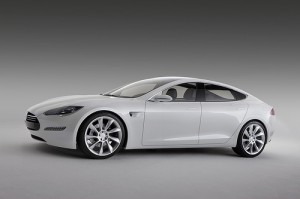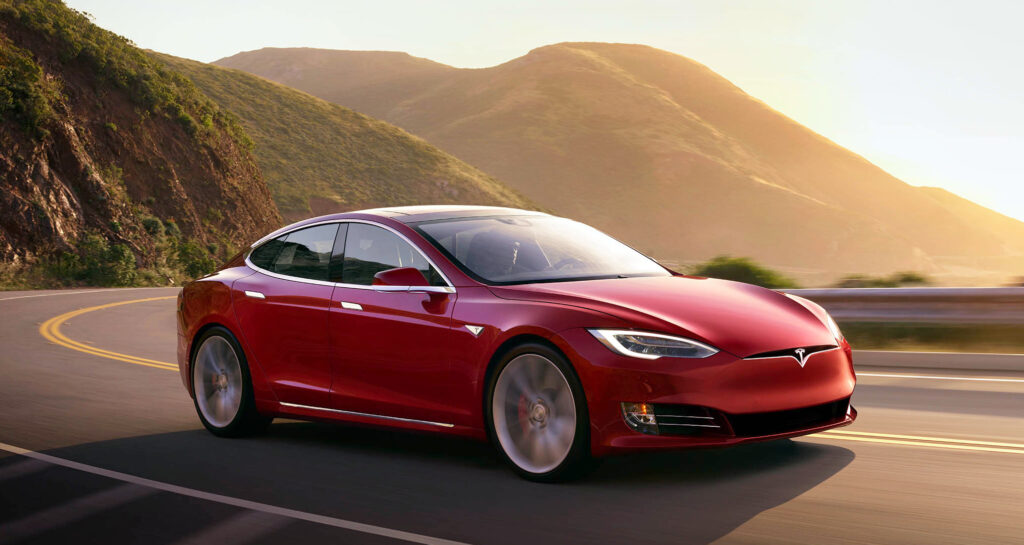 By John Addison (updated 5/5/11; original 1/25/11)
By John Addison (updated 5/5/11; original 1/25/11)
Elon Musk discussed the new Model S Sedan and hinted about the Tesla Model X SUV when he keynoted the Clean-tech Investor Summit. He then gave me an interesting answer about Tesla’s future.
Tesla Model S with New Lithium Batteries
Elon Musk, Tesla’s CEO and Founder, showed us a video of the Model S test drive. This premium four-door sedan easily seats 5 and with small kids could seat 7. The sedan aluminum body and frame Tesla EV is a new design in contrast with the Roadster which uses a Lotus body.
A new generation of lithium batteries is at the heart of the vehicles range of 160 miles with optional packs that provide 230 and 300 miles of range per electric charge. Tesla has reduced the cost of battery packs by integrating consumer 18650 sized lithium batteries. Panasonic, a Tesla stockholder and partner, has developed a new dedicated automotive cell 18650 sized that will give the Model S a 50 percent improved energy density over the Roadster. The Roadster has a 56kWh pack, stated Musk, for a 245 mile range. The larger and heavier Model S can have up to a 90kWh pack, stated Musk, for up to 300 mile range.

To make the Model S sedan roomy, the slim designed pack will be under the floor of the car for plenty of leg room. The battery pack endows Model S with an exceptionally low center of gravity, enhancing stability and minimizing corner roll. Musk committed that the pack would be removeable, a potential advantage in countries like Israel and fleet applications like limos where battery switch stations are being installed.
Tesla plans to continue to provide all sales and service, rather than use dealers. He feels that most customers find buying a car their worst experience. In contrast he wants the experience of getting a Model S to be so positive that someone would buy the vehicle even if it were not electric. 4,600 customers have made reservations for the Model S with a starting price of $57,400.
Model X SUV and Tesla’s Future
Later this year Tesla will formally announce the new Model X SUV. Other than smiling like a proud father, he offered few hints about the new SUV which will be announced towards the end of this year. My guess is that it will have significant differences from the Toyota RAV4 EV Power by Tesla. The Model X could use the Model S chassis, frame, and under the floor battery pack. Clean Fleet Report speculates that the Model X is likely to have extended range options, cost more, and have more aerodynamic crossover features.

By 2015, Tesla also plans on selling a smaller sedan for under $30,000. The future car will need to continue to differentiate itself with styling and range. By 2015, several auto makers are likely to offer electric cars at less than $30,000 including Honda, Ford, Mitsubishi, Toyota, and new Chinese competitors.
I asked Elon Musk how he could manage two different business models: (1) making and selling cars and (2) being a tier 1 supplier to competitive automotive companies. Musk answered that both are consistent with Tesla’s vision of being the catalyst for electric vehicles. If he ever had to choose between being an auto maker and a supplier, he would choose auto maker. In technology fields, however, “coopetition” has long been successful with companies licensing technology, adding innovations to open source platforms, supplying on one day, and competing the next.
Elon Musk a Role Model for Entrepreneurs
Like Google’s founders, Elon Musk is another Stanford University grad student drop out. He left to help found PayPal which netted him $180 million after taxes when it was sold to EBay. Barely 30 years old, Elon considered what to do with the rest of his life. Elon asked himself, “What would make the world better?” The internet, sustainable energy, and space exploration all topped his personal list.
With the money Musk invested in SpaceX and Tesla. He reminisced, “Tesla went close to death on many occasions.” After putting in more personal money to keep Tesla alive, he had gone through all $180 million, and had to borrow money from friends at times.
Auto industry history is littered with visionaries that built a better car only to go bankrupt. Speaking to over 400 executives at the The Clean-Tech Investor Summit, co-produced by International Business Forum and Clean Edge, Elon Musk gives this advice to all entrepreneurs, “If you are convinced that you are correct, you should never give up.”
Elon knew that there was passionate enthusiasm for electric cars when he saw the movie Who Killed the Electric Car. “A candle light vigil for crushing of EV1 was unusual.” He added dryly, “Especially for a GM car.”
The Tesla team overcame the obstacles and built an electric car for windy roads, icy streets, and high-speed freeways. Over 1,500 are driving the Tesla Roadster. A greater number have made deposits for the new Model S. Tesla is now a public company and a battery and powertrain provider for global giants Toyota and Daimler.
Elon Musk envisions a major transformation for the one billion vehicles now on the roads of this earth. By 2020, battery technology and possibly solid-state capacitor technology will make electric cars inexpensive. By 2030, he predicts that the majority of new car sales will be pure electric, not plug-in hybrid, hybrid, or ICE. By 2050, Elon Musk predicts that the majority of cars on the road will be pure electric
Tesla cannot be dismissed as a one-car wonder as it brings out drive system for the Toyota RAV4 EV, the Tesla Model S, and the Tesla Model X. Yes, Elon Musk has stellar ambitions, but the company is executing.
Tesla Motors is the first American automobile company to have an IPO since Ford Motor in 1956. Industry and media accolades continue to be received. Daimler, Toyota, and Panasonic have all invested in the company. While critics say that Elon Musk’s vision of electric cars will not happen, some of the industries best and brightest are betting millions that he and the Tesla team will make it happen.

The article is confused on several points. The quickly removable battery packs have nothing to do with Better Place. With 300 miles of range or less (when
coupled with Tesla’s quick charge capability), Better Place has had the final nail driven into its coffin. It no longer makes any sense, if it ever did. Better Place cannot exist with bateries as cheap and quick charging as they are nowadays. A shortsighted concept, to be sure. Too much emotion and not enough gray matter involved.
I believe the roadster battery pack is 53,not 56 kWhrs and the Model
S has been reported as considerably less than 90 kWhrs for their 300 mile option pack. The author should have referenced where his numbers came from. The Fisker Karma, BYD 6DM and especially Chevy Volt were designed to avoid range anxiety, but the Tesla Model S has the same range as any of them, probably more, since it’s likely, like the roadster, that its claimed range is conservative. As for Musk’s business acumen, I see that the only reason the Model S is going to production is from a $465 million no-collateral Federal loan, plus a multi-million dollar “bonus(?) ” to workers at the NUMMI plant they bought from GM. On the other hand, the Feds gave Fisker over half a billion dollars to build his inferior driving-ranged, slower $90K rich man’s hybrid, which in performance mode runs its gas engine( unbelievable!!!). Nothing like the bizarre logic of our current Dept of Energy.
Raymond, this answers your criticisms. The battery sizes were stated by Musk in his speech. Better Place was not mentioned in this article. Please refer to my latest article about Better Place to understand their business model. No battery switch is required to reach 300 miles in the Model S with the largest battery. You’re entitled to your political beliefs. You criticized the DOE loan guarantee, but did not criticize oil subsidies.